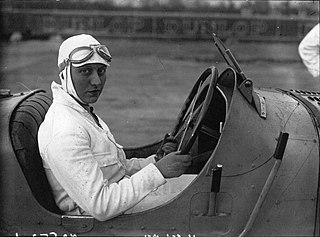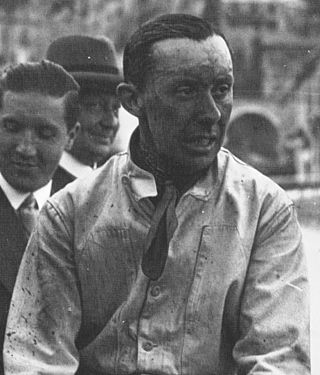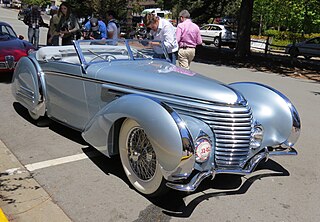Related Research Articles

Automobiles Ettore Bugatti was a German then French manufacturer of high-performance automobiles. The company was founded in 1909 in the then-German city of Molsheim, Alsace, by the Italian-born industrial designer Ettore Bugatti. The cars were known for their design beauty and numerous race victories. Famous Bugatti automobiles include the Type 35 Grand Prix cars, the Type 41 "Royale", the Type 57 "Atlantic" and the Type 55 sports car.

Mariette Hélène Delangle (1900–1984), better known by her stage name Hellé Nice, was a French dancer and motor racing driver. She danced in Paris at the Hôtel Ritz, Olympia Hall and Casino de Paris, before her career was ended by a skiing accident. She then became a racing driver, using roadster cars built by companies such as Alfa Romeo, Bugatti, DKW, Ford, Hispano-Suiza, Renault and Rosengart. She competed in various Grand Prix motor racing, hillclimbing and rally events at a time when it was rare for a woman to do so. She won the Grand Prix Féminin and the Actor's Championship in 1929. Already famous in Paris, she became a household name in France in the early 1930s and raced as an exhibition dirt track driver for a season in the United States.
The Grand Prix du Comminges was an automobile race held in France.

Harry Lawrence O'Reilly Schell was an American racing driver. He was the first American driver to start a Formula One Grand Prix.
Charles Pozzi was a French racing driver who participated in one World Championship Formula One race in 1950, the year of its inception.

René Albert Dreyfus was a French racing driver active during the 1930s and 1940s.

Delahaye was a family-owned automobile manufacturing company, founded by Émile Delahaye in 1894 in Tours, France. Manufacturing was moved to Paris following incorporation in 1898 with two marriage-related brothers-in-law, George Morane and Leon Desmarais, as Emile Delahaye's equal partners. The company built a low volume line of limited production luxury cars with coachbuilt bodies; trucks; utility and commercial vehicles; buses; and fire-trucks. Delahaye made a number of technical innovations, particular in its early years. After establishing a racing department in 1932, the company came to prominence in France in the mid-to-late 1930s, first with the International record-breaking Type 138; then, the Type 135 that famously evolved into the special short-wheelbase sports-racing Type 135CS; followed by the V12 types 145 and 155 racecars. Many races were won, and records set. The company faced setbacks due to the Second World War, and was taken over by amalgamation with arch competitor Hotchkiss in 1954. Both were absorbed by the large Brandt manufacturing organization, within months, with automotive products ended. Delahaye closed forever at the end of 1954, taking Delage along with it.

The 1949 24 Hours of Le Mans was the 17th Grand Prix of Endurance, and took place on 25 and 26 June 1949. Luigi Chinetti won the race for a third time in the first Ferrari barchetta by driving 22.5 hours. This race also saw the death of British driver Pierre Maréchal when his Aston Martin DB2 was involved in an accident between Arnage and Maison Blanche around 1:00 a.m. Marechal had attempted to pass another car there and he hit an embankment and the hapless Briton was crushed by the overturning car.

The 1937 24 Hours of Le Mans was the 14th Grand Prix of Endurance. It took place at the Circuit de la Sarthe on 19 and 20 June 1937. The race was won by Jean-Pierre Wimille and Robert Benoist in Roger Labric's works-supported Bugatti team, in one of the streamlined new Type 57G cars, at a record pace and exceeding 2000 miles in the race for the first time.

The 1935 24 Hours of Le Mans was the 13th Grand Prix of Endurance. It took place at the Circuit de la Sarthe on 15 and 16 June 1935. The race was won by Johnny Hindmarsh and Luis Fontés in a British Lagonda, breaking the run of four consecutive Alfa Romeo victories. A record number of 58 starters included a record number of British cars, at 37, dominating the smaller classes. Another notable point of the entry was four all-female cars, and a Le Mans record of ten women competing.

Formula Libre, also known as Formule Libre, is a form of automobile racing allowing a wide variety of types, ages and makes of purpose-built racing cars to compete "head to head". This can make for some interesting matchups, and provides the opportunity for some compelling driving performances against superior machinery. The name translates to "Free Formula" – in Formula Libre races the only regulations typically govern basics such as safety equipment.

René Louis Paul Le Bègue was a French racing driver.

The 1931 Grand Prix season was a watershed year, with the advent of the AIACR European Championship. After several years of Grand Prix racing in the doldrums with little technical development, 1931 saw new models come from all three main manufacturers: Bugatti, Maserati and Alfa Romeo.

The Delahaye Type 175 is a coachbuilt luxury automobile manufactured by French automaker Delahaye. Production build numbers were formally recorded from early 1948 to mid 1951, validating that 107 cars were built in the mechanically cloned three wheelbase series comprising the Types 175/175S, 178 and 180.

The Tunis Grand Prix or Grand Prix de Tunis was a motor race held in the 1920s and 30s in Tunis, the capital of the African colony of the French protectorate of Tunisia.
The Algerian Grand Prix or Grand Prix d'Alger was a motor race held in the 1920s and 1930s at several coastal road courses in the department of French Algeria.

Lucy O'Reilly Schell was an American racing driver, team owner, and businesswoman. Her racing endeavours focused mainly on Grand Prix and rallying. She was the first American woman to compete in an international Grand Prix race and the first woman to establish her own Grand Prix team.

The Delahaye 145 is a luxury car, derived from a racecar design, manufactured by French automaker Delahaye. Based on a sporting tourer, it was designed to be capable for racing.

The Bugatti Type 51 Dubos Coupe is a one-off automobile originally built by Bugatti in 1931 as an open-top Bugatti Type 51 race car that was driven by legendary racer Louis Chiron, and then modified by Louis Dubos to be a luxury road coupe. It is one of the most valuable cars in the world, estimated at around $20 million dollars as of 2023.

Germaine Rouault was a French racing driver.
References
- Anthony Carter (2011). Motor Racing: The Pursuit of Victory 1930-1962. Veloce Publishing Ltd. pp. 16–18. ISBN 9781845842796.